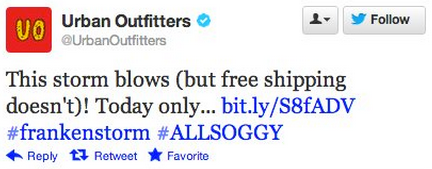Erik Qualman's Blog, page 642
January 31, 2013
A Tidal Wave of Opportunity for Higher Ed

 As I walk around the college campuses I visit, it’s amazing how technology has consumed the student body. The majority of students I see have their earphones plugged in and are texting at a record pace. Tablets and smartphones are everywhere. Yet when I look at the university websites or the landing pages for the different schools on campus, one piece of technology that is often missing is social media. I’ve been to college websites where the graduate school or the school of marketing and communication have no social media presence whatsoever. How can that be? Their customer, their target audience, prospective students, use social media as a primary means of communication. Facebook, Foursquare and YouTube are platforms they engage with almost hourly. So why aren’t the Deans, Provosts, Presidents and PR heads not taking advantage of this medium? I wish I had the answer. I’ve sat across from many them as they candidly dismiss it. Is it age? Is it foreign and overwhelming? Is it money, time, budgets and priorities? I can only speculate. Let’s look at what’s possible with social media.
As I walk around the college campuses I visit, it’s amazing how technology has consumed the student body. The majority of students I see have their earphones plugged in and are texting at a record pace. Tablets and smartphones are everywhere. Yet when I look at the university websites or the landing pages for the different schools on campus, one piece of technology that is often missing is social media. I’ve been to college websites where the graduate school or the school of marketing and communication have no social media presence whatsoever. How can that be? Their customer, their target audience, prospective students, use social media as a primary means of communication. Facebook, Foursquare and YouTube are platforms they engage with almost hourly. So why aren’t the Deans, Provosts, Presidents and PR heads not taking advantage of this medium? I wish I had the answer. I’ve sat across from many them as they candidly dismiss it. Is it age? Is it foreign and overwhelming? Is it money, time, budgets and priorities? I can only speculate. Let’s look at what’s possible with social media.
First, what a valuable recruiting tool it can be. You have the ability to identify the ideal student, connect with them directly AND connect with those within their circle of influence (parents, guidance counselors, friends and family members). You can find out where they are, what they are saying, what they are interested in, who their responding to and topics (i.e. content) they are most responsive to. If they are looking to increase student enrollment, social networks like Facebook and YouTube seem to me like a good place to start.
Second, alumni participation seems to be a constant challenge for most colleges and universities. Where do alumni generally reside on the social web? LinkedIn. Their alumni are peppered all over corporate America, in Fortune 1000 companies or as entrepreneurs and small business owners. If you want to increase alumni participation you have to increase alumni engagement and to do that, you have to know where they reside on the social web and choose to connect and converse with them. Conversations build relationships, relationships build trust and trust will build your business (i.e. student enrollment and alumni donors.)
Third, is there an institution of higher education that is not trying to build their brand? I don’t think so. Social media has over 2 billion users which means the power and reach it has is stunning. Your school projects an image on line and that image is your brand. You either have a positive brand, a negative brand or no brand at all and two of these three are not good. Not having a social media presence is as bad as having a negative online presence. Brands project credibility and set you apart from others. A brand is a uniform and consistent expression of your quality and value. The key word there is consistent. The brand you project must be consistent throughout every marketing channel available to use. Overlooking social media could prove to be a long term and costly mistake.
Fourth, businesses in every community are using social media. They’ve been using networks like LinkedIn for years to identify and hire well educated, talented professionals who could add value to their company or organization. B2C (business to consumer) companies like Diet Coke and Ford, among many others, have found phenomenal success reaching their target audience via social media. B2B (business to business) companies like Intel & IBM have as well. And if you haven’t heard of The Cupcake Stop, the first mobile gourmet cupcake shop (@Cupcakestop), then you’re missing out on a great small business social media success story. Bottom line, students want jobs and promising careers. They need internships and externships. They need to build relationships and uncover opportunities with those in the business community in order to make their investment in higher education worth while. Social media provides that opportunity in spades. Universities who create online communities where companies of every size can connect with the student body and offer them a future career will not only have an incredible story to tell their high school recruits but will have “brand champion alumni” thanking them for an education and a student experience that impacted their lives forever.
Fifth, cost. Now, anyone who tells you social media is free is full of hot air, it’s not. But it is extremely cost effective. What does a school spend on collateral? On advertising? Direct mail? What does it cost to hire warm bodies and pay man hours to people who answer the phone, speak to students, parents, alumni and others when they could be having those conversations online in real time? The investment you make in engaging your audience through social media is a lot less then other traditional methods I can guarantee you that. I’ve heard the argument before, ”we don’t have the budget for that”. Let me respond this way. You can’t harvest what you haven’t planted. You can’t cut your way to growth. Investing in social media now will enable you to leap frog your competition where as if you wait any longer, it will cost a heck of a lot more to catch up. Erik Qualman‘s quote sums it up best, “We dont’ have a choice as to whether we do social media, the question is how well we will do it.”
 So who’s doing it right? Who is Best In Class? You might be surprised. This article, How 9 Greater Boston Area Schools Have Excelled at Social Media is an excellent start. 20 Awesome College Social Campaigns from this School Year is one of my favorite list of examples of those institutions of higher learning just plain “get it”. Looking for an info-graphic to tell the story, I found three excellent ones from Genius Recruiter here. I even came across a Twitter directory for Higher Education. Who knew?
So who’s doing it right? Who is Best In Class? You might be surprised. This article, How 9 Greater Boston Area Schools Have Excelled at Social Media is an excellent start. 20 Awesome College Social Campaigns from this School Year is one of my favorite list of examples of those institutions of higher learning just plain “get it”. Looking for an info-graphic to tell the story, I found three excellent ones from Genius Recruiter here. I even came across a Twitter directory for Higher Education. Who knew?
I’ve gotten to know Dr. James Nolan, President Southwestern College in Santa Fe, New Mexico and I have found his blogs on this topic incredibly fascinating and revealing. He’s one of the few leaders in Higher Ed that not only addresses the topic of social media but makes a compelling case of it’s use as strategic in the long term growth and sustainability of colleges and universities across the globe. Social Media, The Swiss Army Knife of Higher Education is the piece that first caught my attention and specifically this quote “Over the past two to three years, social media has become a primary tool and strategy for recruitment, for marketing, for development, for public relations, for alumni relations and for moving our unique school toward a “thought leadership” position.”
So maybe it’s worth while for the leadership at the collegiate level, the Deans of Students, Alumni, Admissions, the Provosts and Presidents, to step outside their offices, sit in the student unions and watch the students using the newest and latest technology in every shape, matter and form and ask themselves how they could better communicate with their target audience using platforms such as social media. Ask them how they use it, ask them if their parents use it, ask them if the companies their parents work for use it. Ladies and gentlemen, there is a tidal wave of opportunity that sits before you. Is enrollment down? Are donations flatlined or trending in the wrong direction? Are your students hungry for jobs and concerned about graduating without a clear career opportunity in front of them? Social Media can serve as a powerful tool to successfully overcome some of these challenges all schools are facing. If you chose to ignore it, poo poo it, or treat it as a passing fad, this tidal wave of opportunity will quickly turn into a unsuspecting tsunami that will leave your institution miles behind your competition and light years behind in advancing technology. Wake up. Sound the alarm. Get engaged. Think differently. Embrace technology, embrace change and be a leader among your peers and one that others look to thee standard for social media best practices in higher education. Ride the wve and take advantage of the opportunity that sits before you. You’ll look back three years from now and be glad you did (or furious that you didn’t).
“Realize that social media success isn’t big moves on the chess board, it’s little moves made every day that eventually add up to a major shift”...Jay Baer, Social Media Author , Speaker & Coach
[image error]
Interview with Michael Skok, Founder of Startup Secrets

[image error]Any entrepreneur will attest that starting a company is anything but easy. As business gets off the ground, entrepreneurs wrestle balancing long hours, wearing multiple hats, and figuring out problems and issues that distract from the ultimate goal of building a successful company.
Just ask Michael Skok. Michael spent the first twenty one years of his career building companies as an entrepreneur. For the last ten he’s been helping entrepreneurs build their own startups as a Partner at North Bridge Venture Partners. His portfolio includes companies like Acquia, Apperian, Demandware and Unidesk, among others.
I first met Michael a few years back while pitching North Bridge on a company I was starting and had the pleasure of working with Michael. More recently, Michael founded Startup Secrets, a resource and framework for entrepreneurs and innovators to think through some of the key steps that could accelerate their success in starting a business.
I had the chance to sit down with Michael to chat about the mission of Startup Secrets and learn his vision for the future of the group.
Thanks for taking some time this evening Michael. Recently Startup Secrets held a physical event at the Harvard Innovation lab. Can you tell me a little bit about what you covered?
As part of the Startup Secrets series, one of the key areas we are exploring is ‘go-to-market’. For this event we assumed that you’ve built a great value proposition, you have a great team behind you, and you can take your company to market with a business model that can make you money. Ultimately, it then comes down to one of the key aspects of execution, which is, how can you go to market in a profitable way. So this last session in the series focused exclusively on that step. And as usual, we brought it to life with some great case examples from companies like Spotfire/Tibco, Hubspot and others — all available on my site.
How close did this session tie back to business models?
It’s actually the other side of the coin from business models. And these two are so closely tied together in for example pricing and packaging for the right distribution. For this session we made the assumption that the business model was proven and now we are in the process of taking this product or service to market.
How did it go?
The audience was a fairly typical mix for the Startup Secrets series. The room was full of grad students, under grads, and executives from local startups. I spent a lot of time meeting with executives to learn what they want before starting the series and what I uncovered was that they are looking for practical advice. How can they execute and do so by implementing best practices and avoiding mistakes made by other companies. So we spent most of the time presenting practical advice. However, I’m very clear that these are not answers as I don’t believe in prescriptive learning for startups. So the frameworks and examples were designed to structure some of the key areas to consider and examples to highlight and inspire possibilities.
Can you tell me a bit more about how the sessions are structured?
We approach each topic in two parts; the first being the framework. The framework in the case of the last session was ‘here are the things you need to consider in a go-to-market plan’. Go-To-Market is such a broad subject. In fact, it is probably the biggest subject we cover. So within that, we break down GTM further into small digestible bits like ‘how to architect a sales cycle’ – from awareness all the way through to closed-business. We then dig into the ways or methodologies for accomplishing that. For example, inbound vs outbound marketing, positioning and messaging, budgeting, etc.
We then illustrate the topic through featured case studies and speakers. For the session focused on ‘inbound vs outbound marketing’ I had HubSpot CEO Brian Halligan stop by to speak with the group. We then spent some time talking about messaging and how you want your company branded. For that portion we had Jamus Driscoll, CMO of Demandware, chat with the group.
That is great. Two heavy hitters like Brian and Jamus come in and give practical advice to start-ups. Is this appropriate for established, more mature companies as well?
Absolutely, in fact we have been seeing an increase in established companies attending and benefiting from the content. Demandware is one of my public and more mature companies for example and another of my companies Acquia is #1 on the Inc. 500 as the fastest growing software company in America – so again, a more mature company on its way to an IPO. And then others like Apperian are in between. Also, I’m always looking for great case examples outside my portfolio such as uTest who did a great case example. Actually, many of these have been the most vocal in praising the content and value they get from the session.
How can people join the group and benefit from the content you are producing?
The easiest way to get involved is to visit www.mjskok.com and sign up. I recommend you review the frameworks in the following order, though you can pick and choose whatever suits you from any section and explore a growing number of Videos, Slideshows, Articles and Case examples in each area.
1. Building a compelling value proposition
2. Company formation – vision, mission, culture and hiring
3. Game Changing Business Models
5. Getting behind the Perfect Pitch
The logic behind this order is that you probably don’t have a company to start without a value proposition. Then as you start it, defining your vision, mission and culture become critical to hiring the right people. Next, thinking about your business model and go-to-market strategy become key elements. And finally – putting it all together in a pitch you can use to raise money rounds it out.
Additional topics will be covered in the 2013 series, kicking off March 7. Details on those sessions can also be found on the site.
It was excellent catching up with Michael but I’d like to share your feedback with him. What do you think of the topics? Is there anything else you would like to see covered? Please share your thoughts in the comments section below.
[image error]
The Social Help Desk Revolution

Every day social networks are growing at an alarming rate. While Twitter is averaging 250 million tweets per day, Facebook has grown to over 900 million active users. This means that now for every five minutes spent online, one of those minutes is spent solely on social media sites.
Every week over one million people view customer service related tweets, with 80 percent of them being negative. Understanding and responding to the needs of your customers is crucial, because 59 percent of consumers will switch brands for better service.
Click to Enlarge Image

The Social Help Desk Revolution — Brought To You By Desk.com
[image error]
January 30, 2013
Get Real on Using Social Media

Many different industries have come to find in recent years how beneficial social media can be to their respective needs.
Whether you sell vehicles, insurance, beauty products or real estate, you should definitely have your hands in the social media cookie jar. If you don’t, you could find yourself going hungry when it comes to landing more sales.
Speaking of real estate, how many agents out there are actively involved in social media? If that show of hands was low, you may want to reconsider avoiding social media, instead listening to all the good things it can mean for your business.
According to a 2011 report from Postling.com, 84 percent of real estate agents nationwide had delved into social media. Of that percentage, 55 percent report being “comfortable” in using social media, with 10 percent reporting they are “uncomfortable” using it. Lastly, nine percent claim to not use it at all.
For those last two groups, that being the uncomfortable group and those not using it, perhaps 2013 is the year you find out how much social media can mean to your business?
If you have been hesitant to get more social, keep the following in mind:
* Time is of the essence – One of the best reasons to partake in social media is it improves your chances of meeting new clients. By being on Facebook, Twitter, LinkedIn, Pinterest and some of the other notable social sites, you can meet and engage with the public (both those looking for a rental or purchase for their personal or professional needs) in real-time. Unlike meeting potential customers in your office or on the road, there are obviously no time restrictions when it comes to social media;
* What’s my competition up to? – Social media also offers a great opportunity to see what other real estate agents are up to. Whether it is your competition right here in town or other pros nationwide, you can pick up some pointers by seeing how they interact on SM with current and potential customers. Especially for younger agents, it never hurts to see how other agents market their business to consumers, meaning you can see what approaches work and which may not. If you end up befriending and/or following other agents and vice-versa, more consumers will come to see you as a central figure in the industry (see below);
* The need to be an authority – One of the best ways to rise to the top of the real estate charts is if buyers and sellers see you as an authoritative figure in the industry. By using social media, you not only engage with buyers and sellers, but you provide them with useful links to trends in the market overall that can impact when and where they buy. You also educate them on how to go about buying or selling a home, the importance of finding the right title companies to secure title insurance, and what possible legal glitches could thwart their efforts to buy or sell a property, this through YouTube videos and other online channels. Finally, you keep their interest in you and your services by uploading daily photos of places for sale to sites such as Pinterest. In all, more people will see you as the go-to agent when it comes to their real estate needs;
* Speak with your own voice – Lastly, there may be the urge on your part to outsource your social media and promotional needs. Before you do such a thing, think about the voice that will come across to current and potential customers. One of the many advantages to using social media is having your own voice. If the shares, tweets, and other posts seem to be too generic, you may lose touch with a number of consumers on social media. Yes, social media does take time and effort, but the rewards of being social can be very beneficial to your business.
If you have been hesitant to close the deal on an active social media presence, you should really think about buying into it this year.
Photo credit: unitededucational.com
[image error]
10 iPhone Apps for Editing Photos

 Apple’s iPhone is one of the most popular mobile devices on the market, powerful enough to manage every detail of your personal or professional schedule, boost your productivity and simplify a staggering assortment of daily tasks. It also has a high-quality camera built into the device, allowing you to capture memories as they happen, no matter where you are. Unfortunately, spur-of-the-moment snapshots can be plagued with lighting or composition problems that negatively affect the quality of the photos you take. These ten apps can correct some of those issues, or simply add some interesting, eye-catching effects to your iPhone photographs.
Apple’s iPhone is one of the most popular mobile devices on the market, powerful enough to manage every detail of your personal or professional schedule, boost your productivity and simplify a staggering assortment of daily tasks. It also has a high-quality camera built into the device, allowing you to capture memories as they happen, no matter where you are. Unfortunately, spur-of-the-moment snapshots can be plagued with lighting or composition problems that negatively affect the quality of the photos you take. These ten apps can correct some of those issues, or simply add some interesting, eye-catching effects to your iPhone photographs.
Frametastic – Sometimes all a photograph needs to be perfect is a tasteful frame. Others may need a few effects to jazz them up or an interesting texture. This free app allows you to do all of those things, as well as sending a glossy, printed postcard version of your iPhone photographs anywhere in the world for $0.99! Frametastic is a great tool for capturing and sharing vacation memories, as well as everyday moments that you don’t want to ever forget.
FX Photo Studio – This $0.99 app comes with more than 190 effects, labels and tools to make your photos come to life, all of which can be mixed and matched to create truly unique works of art. CNET says that “FX Photo Studio has become one of the best in the iTunes App Store” and that “it’d be silly not to get it.” Join the ranks of professional photographers and amateur enthusiasts that call FX Photo Studio a favorite way to edit, post and send their photos.
Snapseed – Free in the app store, Snapseed is one of the most popular and powerful photo editing apps in the App Store. In addition to the Auto Correct, Tune Image and Selective Adjust tools, Snapseed also features filters and effects that can truly make your photos shine. Built-in Google+ capabilities simplify the process of sharing those precious photos with family and friends, along with other popular built-in sharing options.
Filterstorm – One of the more expensive offerings in the App Store’s photo editing realm, Filterstorm is an exceedingly powerful app that gives users professional-quality tools and features at a fraction of the cost of desktop photo editing programs. If you’re having trouble navigating the world of in-depth photo editing, the Filterstorm website features tutorial videos that are also linked within the app for ease of viewing.
Luminance – Built-in presets and tools that allow you to customize your photos as you see fit are among the features offered by this $0.99 app, which allows users to add and adjust as many layers as they want, as well as exporting full resolution versions of their work and sharing them to Facebook, Camera Roll and Twitter.
PhotoForge2 – The $3.99 price tag puts PhotoForge2 firmly in the higher-end category, but is a steal when you consider all of the features and tools at a PhotoForge2 user’s disposal. Filters, effects and the ability to manipulate composites of multiple photos are standout offerings, but the fact that PhotoForge allows you to edit a full resolution image rather than previews generated by other editing apps is what truly sets it apart.
Photosynth – Sometimes there’s just too much beauty for one photo to capture, which is where Microsoft’s free Photosynth app comes in handy. You can easily create seamless interactive panoramas, not just horizontally but also vertically to create a “sphere” effect.
TouchRetouch – If you’ve ever snapped a picture that inadvertently included objects you didn’t want to capture, you’ll understand the value of this $0.99 app. Simply mark the items you want to remove and tap “Go,” and TouchRetouch will do all the work! From unwanted “photobombers” to power lines and poles that sully a beautiful view, TouchRetouch allows you to make your photographs match the image in your mind’s eye.
Adobe Photoshop Express – Adobe Photoshop is indisputably one of the most recognized names in photo editing software. This free app brings some of the most common features to your iPhone, allowing you to improve your photos, add effects and filters with no fuss or being forced to learn complicated desktop software.
ShakeIt – If there’s a part of you that misses the days of shaking an instant photo and watching the image slowly emerge as it develops, this $0.99 app is for you. Recreating the experience beautifully, ShakeIt lets you choose a frame, watch your photo develop and then easily share it through email or Facebook.
While it’s exciting and convenient to be able to snap a photo, edit it and share it with all of your loved ones with a few taps, it’s important to remember that editing photographs or posting them to social networking sites is just as dangerous while you’re driving as sending text messages or emails. Make sure that the next photo you take isn’t of your damaged car or a citation from the police for being caught illegally using your phone during your commute, and keep in mind that the implications of driving while distracted can be even more far-reaching if an accident you cause is a serious one.
Article from: http://www.longhornleads.com
[image error]
January 29, 2013
The Biggest Twitter Fails of 2012

There have been some epic fails on Twitter this year proving the important point that many multinational brands are still not adept at using social media to interact with their customer base. The monumental mistakes have provided yet more evidence that social media campaigns are still in their teething stage. Please note that the crass terms, especially the ugly four letter word starting with r, you will read below are not condoned by the editors of Socialnomics, we are using these as examples of what not to do.
5. Twit-rape –
A crass term for what’s meant to be a harmless and amusing jape. When a friend or family member leaves themselves signed in to their account and some joker comes along to post an embarrassing tweet it can certainly be comical. Less so however when you do it to your own boss, as was the case with an English intern working for a local MP. In January Tom Watson, a British Labour party politician, apparently tweeted “I should log out of my twitter so my intern doesn’t twit-rape me…”
The intern soon realised her faux-pas and the tweet was deleted, not soon enough however. As is the case with social media and comical content, within minutes the tweet was retweeted and the post had travelled around the world and been seen by hundreds of thousands of people.
Tom Watson, back behind the steering wheel of his Twitter handle, posted a follow-up tweet which read; “I sincerely appoligise for the recent tweet. A lesson learned for a young intern. She’s also very sorry. I will deal with the matter offline.” Interestingly though, Tom Watson’s followers skyrocketed from the tens of thousands to well over one hundred thousand. So, in the long run, not exactly a fail.
4. #WaitroseReasons –
The first (but not the worst) misjudged hashtag in our 2012 round up. Upper echelon supermarket chain Waitrose invited their followers to Tweet under the hashtag #WaitroseReasons and to complete the sentence, “I shop at Waitrose because…” Of course, the reasons offered up by the Twitterverse weren’t always positive, often ridiculing the brand.
Arguably, however, it wasn’t a total disaster. Many online commentators believe that Waitrose knew exactly what they were doing, fully aware of the middle and upper class clientele that typically shop in their stores and rather than denounce the chain, the resulting tweets actually reinforced its posh and exclusive brand image.
3. #McDStories –
Unlike #WaitroseReasons this hashtag was a straight-up disaster. Considering the fastfood chain’s history it’s hard to believe that they honestly thought that the public would only have good things to say about the brand. The company encouraged its Twitter followers to post about their experiences with McDonalds and of course, the hashtag was immediately hijacked with people Tweeting their horror stories involving food poisoning, hospitalisation, rats, broken teeth and fingernails found in Big Macs.
This PR debacle did give rise to the term Bashtag which clearly demonstrates that social media conversations cannot be controlled and when you’re planning out your social media campaign it’s best to have a contingency if the worst case scenario plays out, which it almost always will.
Online people converse about any manner of things and on many different channels from chat specific sites to niche forums and blogs. The point is, it’s impossible to control the crowd and the discussion will flow where it wants. MacDonalds learnt this the hard way, even after they hastily pulled the hashtag it was way too late, those horror stories had been shared globally between hundreds of thousands of people.
2. Capitalising on a natural disaster –
Hurricane Sandy resulted in millions of people on America’s East Coast being made homeless and without food or power for weeks. Unfortunately some misguided retailers thought it would be acceptable to use the storm to promote their cheaper shipping rates.
Urban Outfitters, The Gap and American Apparel all revealed themselves to be opportunistic and tasteless with their insensitive promotional Tweets. Unsurprisingly this did their images no favours, especially for American Apparel who is embroiled in several well publicised legal cases. The Gap apologised profusely and deleted the incriminating post and hopefully learned a valuable lesson; the same level of humanity and social etiquette should be met online it is in real life.
1. #Susanalbumparty –
Another poorly thought through hashtag that’s undeniably hilarious. This acted as a loud and clear message to PR agencies across the world, if you’re using social media it’s sometimes worth having a dirty mind and getting your copy proofed before you commit to press.
You’d think the PR team behind Susan Boyle would know better, there have already been a plethora of unfortunate hashtags highlighting the problems that arise when you put words together. Although the hashtag was the butt of many jokes it did accrue Susan Boyle’s album even more media and public attention, so perhaps another case of failure hiding success.
[image error]
Harvard, Michigan, and MIT top the social charts

According to Klout, Harvard, Michigan, MIT, Princeton and Stanford are the top 5 most influential universities in the United States. While much has, can, and will be debated around the Klout algorithm, it is still a fascinating chart to review. One point of interest is Harvard and MIT are being #1 and #3 respectively. Harvard and MIT have always ben ahead of the curve and they recently initiated the free, non-profit, online learning organization edX. edX is also something you should check out today. We are truly at the beginning of the education revolution.

Klout ranks the top Universities in the U.S. based on their digital footprint and influence
Click here for the full Klout University Rankings
[image error]
January 28, 2013
Importance of Pinterest as an Extension of Your Brand

Pinterest has become one of the biggest and fastest growing social networking sites out there. Its easy to use, graphical platform coupled with the seemingly endless supply of new things to look at make it one of those time warp destinations. You know, one of those sites you go on, and the next thing you know its 3am and you realize you haven’t even blinked in over 6 hours (see also: Reddit, Foodgawker, Worldstarhiphop). Yea, one of those. It is for this exact reason that Pinterest is the perfect platform for businesses trying to engage with their audience. With a little bit of forethought and dedication, small businesses with little resources are able to compete with those bigger brands.
Use Pinterest as an extension of your brand
Branding is way more than just your logo, slogan and color scheme. It is every aspect of your business. I always suggest to my clients to look at their branding strategies through the 5 senses, making sure all of them are stimulated. Although this strategy is much simpler to execute in a brick-and-mortar location, it isn’t impossible to appeal to them virtually. By pinning relevant material that cater to your audience’s five senses, your customers can get a better idea of what you stand for. For example, a small, neighborhood taqueria specializing in Northern Mexican cuisine could use a pinterest account to:
Stimulate the eyes by posting beautiful pictures of the Sierra Madre Oriental mountain range in Monterrey.
Stimulate the ears by posting music videos and live performances from some of musicians originating from northern Mexico.
Appeal to the sense of smell by featuring pictures and recipes where cilantro and other potent herbs or spices are used.
Stimulating taste should be the easiest in this example and can be done in conjunction with smell with beautiful pictures of food and recipies.
Appealing to the sense of touch, although the most difficult to execute virtually, can be done with the use of great quotes and poems. It can even occur in terms of the level of feedback and conversation you have with your followers and those you follow.
Although every business is different, the strategy suggested here can be used by all sorts of businesses in all sorts of industries. By curating a virtual experience, not only do you give your audience a better sense of what your business stands for, but posts that are intriguing, relevant and aesthetically pleasing often get re-pinned, spreading your message virally and helping your customer base grow!
[image error]
January 27, 2013
Do You Have the Energy to Save Money?

 With a new year and new opportunities for you to save money, just how much effort will you put into making sure there is more green in your wallet or purse at the end of the day?
With a new year and new opportunities for you to save money, just how much effort will you put into making sure there is more green in your wallet or purse at the end of the day?
One such way is to turn to social media to see how going green can actually cut down on your expenses, both at home and when you go to shop.
Although the green movement has met with mixed results in households across the country, many individuals and families for that matter, have turned to recycling, buying organic food, and purchasing appliances for their homes, ultimately saving them money.
One of the ways to go about this is by using social media to get the latest green news.
According to 2012 research from ComScore, social networking websites reach home to more than 80 percent of global Internet users. Meantime, Econsultancy reported that just over 90 percent of businesses claim social media is becoming key to their overall marketing plan.
With those numbers in mind, consumers should look to numerous green companies and their social media pages (Facebook, Twitter, Pinterest, Google+ etc.), reading up on how to save money in their daily lives by being more green.
Among some of the ways consumers can save include:
* Recycling – If you have not been taking your cans, bottles, newspapers, boxes and other such items to a recycling center or store for monetary refunds, you’re already missing out on savings. Gather up the items once a month, allowing you to not only give yourself more space at home, but also provide you with a few extra dollars in your wallet;
* Organic foods – Along with ultimately saving you money over time, such foods allow you to eat a number of different items without being exposed to harmful chemicals and preservatives. You can oftentimes find local farmers selling organic foods, while you can also grow your own at home if you have room for gardening;
* Energy-saving appliances – You could be seeing money literally blow out your window or door if a number of your appliances are old and not working up to capacity. Look for Energy Star appliances when it comes to items like air conditioners, washers and dryers, refrigerators, and more. Energy efficient products can end up saving you and your family (where applicable) approximately 33 percent on your energy bill, including similar savings when it comes to greenhouse gas emissions. From Louisville air conditioning to a host of providers and products, take the chill or the heat out of spending money by finding the right appliances for your home;
* Stay social and reap the rewards – Finally, another good reason to review the social media efforts of green companies is gleaning information, including area green events in your neighborhood, new proposed regulations and policies that will have an impact on the environment, environmental trade shows, and more. Make sure you befriend or follow some of the top sites, allowing you to stay on top of educational material, ask questions of green companies when it comes to relative issues, and find other individuals who are or already have gone green.
Along with the good it does for the environment, going green can put more of that in your wallet or purse.
Photo credit: shine.yahoo.com
[image error]
January 26, 2013
Get Social In Remodeling Your Pitch to Consumers

 It seems you can use social media for just about anything these days, especially when it means reaching out to consumers looking to spend money on remodeling their homes.
It seems you can use social media for just about anything these days, especially when it means reaching out to consumers looking to spend money on remodeling their homes.
With that in mind, while the weather may be cold and frightful for a sizable portion of the nation, spring is actually not too far around the corner. As many people are apt to do, spring is a good time to work around the house, getting it in shape for those outdoor summer parties and more.
More and more home decorating, remodeling, and service providers are turning to social media these days in order to reach out to potential customers, finding it to be a good medium to start a conversation.
According to a recent Pew Internet & American Life Project report, 82 percent of residents nationwide over the age of 18 turn to the Internet on a daily basis, with more than 50 percent of American adults older than 65 doing the same. Given those numbers, you would almost be foolish in 2013 not remodeling your approach to social media if it hasn’t been very stellar to date.
Should you be looking to ramp up your social media outreach to consumers, there are ways to go about it, including:
* Be proactive – First and foremost, be consistent and relevant on your social media pages, be they Facebook, Twitter, Pinterest, and more. You can’t take the approach of just showing up from time to time, you need a consistent presence that shows the consumers you are serious about what you do. Use social media to engage the consumer, helping them out with their questions and/or issues. Offer homeowners and renters looking to change the look of their residence both ideas and solutions, making you there go-to expert. Being proactive also allows you to hear the chatter online regarding your company, something you should definitely be in-tune with;
* Blogs do work – If you have a company blog dedicated to home fix-ups and remodeling, by all means use it. The blog is a great way for you to share your knowledge, promote some of the ideas other homeowners and renters have tried and worked, and even offer guest blog posts from other experts in the home remodeling industry. When the time comes for the consumer to want to do work on their residence, you already have in place a pool of ideas to make the job of remodeling that much easier, plus less costly to the individual;
* Pictures and videos – While Pinterest has taken off, there are other means that you can also turn to in order to give those updating their residences imagery to chew on. Having home remodeling videos and/or virtual home remodeling tours on your website is a great way to share ideas with those looking to add an extra room onto their property, remodel a kitchen or bedroom, install an outdoor deck or patio, put in place the proper gutter styles, or throw a few fresh coats of paint on the interior or outside of the homes. When using such imagery, make sure it is appealing, not to mention leaving a call to action;
* Take a look around – The last thing you can and should do is see what other home remodeling companies are doing with their social media and overall web presence. While you certainly do not want to copy their efforts, get an idea of what seems to work and not work for them. Incorporating an idea or two from others into your overall social approach can’t hurt.
If this is the year you hope your home remodeling business takes off, being a little more social about it is a good start.
Photo credit: zippyshell.com
[image error]










